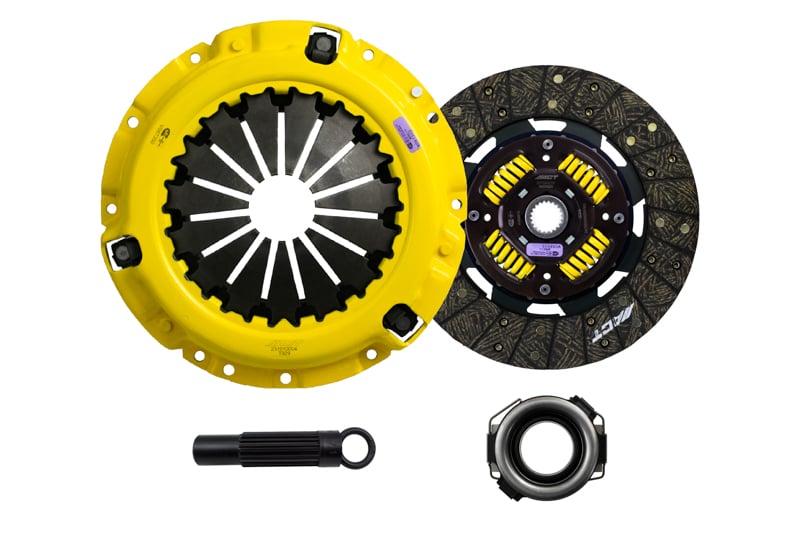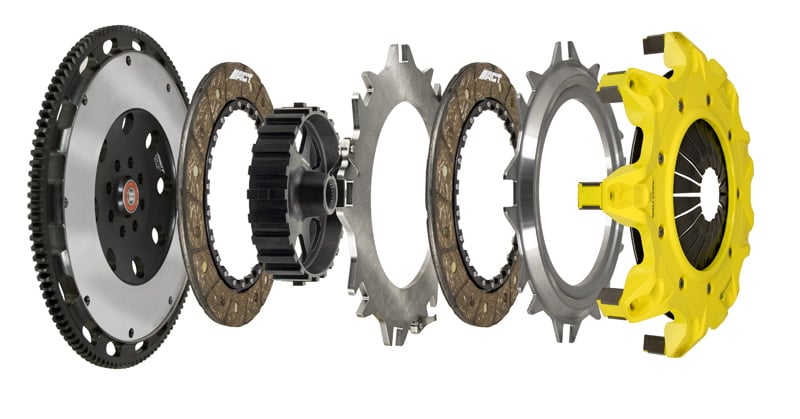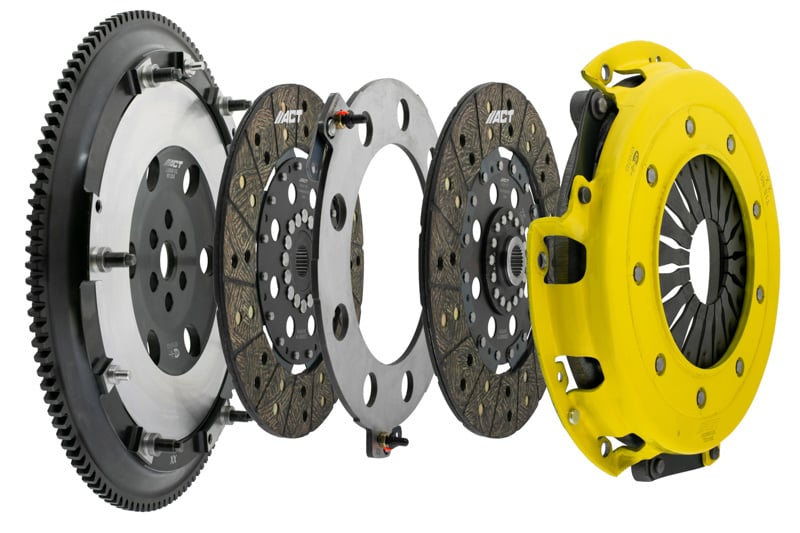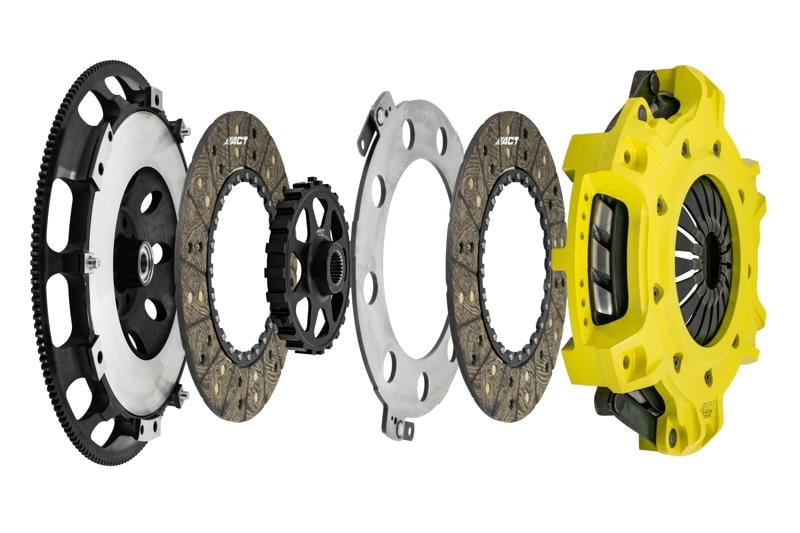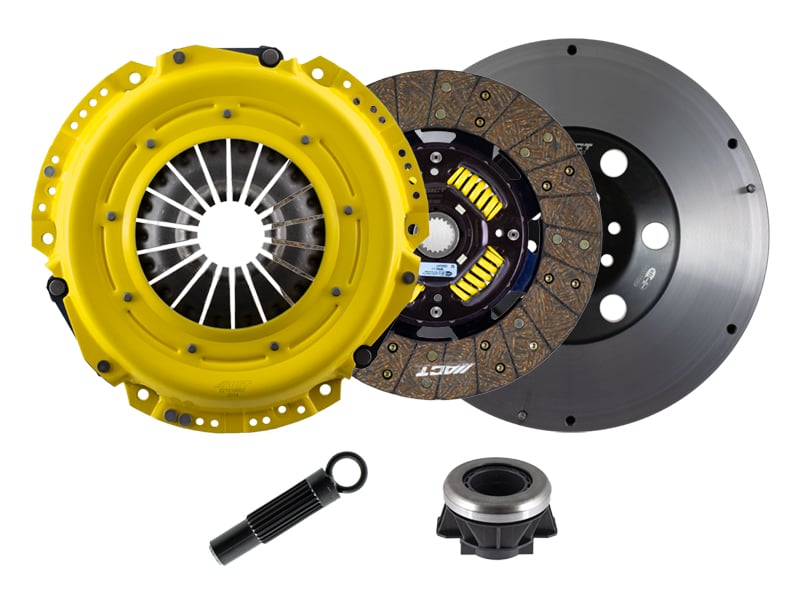ACT Technical Bulletins
-
August 06, 2020
Recently, our technical department received some questions about dual-friction clutch discs. Here’s why ACT chooses to go with the same friction materials on each side of our clutch discs.
Two of the most important concepts in performance clutch functionality are flatness and parallelism. When using anything other than identical friction materials on each side of a clutch disc, the differences in thermal conductivity and coefficient of friction create an unavoidable variance in temperature between the two disc surfaces as the clutch heats up. This temperature difference, combined with the unmatched thermal expansion properties, creates a condition where the disc is vulnerable to deforming out of flat and, in some cases, out of parallel as well.
Out of flat and out of parallel discs contribute to poor shifting (more pedal travel required), clutch drag and judder. You want a flat cracker but you might end up with a wavy potato chip.
Have clutch-related questions you...
-
August 06, 2020
Gear Rattle
Increased gear rattle noise may occur when changing to an aftermarket performance clutch and/or flywheel, including ACT’s products. The most common gear rattle noise occurs when a vehicle is idling in neutral after a long drive or on a hot day. It sounds like a light knocking or growling sound. Gear rattle is an audible noise transmitted from the impacts between the transmission gear teeth. A vehicle engine’s torsional vibrations (momentary angular acceleration) pass through a transmission causing the separation and resulting impact of the gear teeth. Gear rattle is not to be confused with clutch chatter or out-of-balance vibrations; both of which are conditions mostly felt and generally, not heard. In general, gear rattle is not harmful to the transmission, but can be an annoyance to the driver. It can become a serious concern if misdiagnosed as a transmission or engine problem. Traditionally, automakers have dampened torsional vibrations by using a clutch disc with...
-
August 06, 2020
Check Engine Light When Using a Lightened Flywheel on the Subaru WRX
When using a lightened flywheel with the Subaru WRX, the check engine light (CEL) has been known to come on for no reason on some vehicles. Because the high inertia of the factory flywheel is not there to smooth out the idle, it can be slightly rougher than stock with a lightweight, aftermarket flywheel. The CEL is the ECU interpreting the change in idle as a misfire in the electrical system. There is no misfire in the electrical system, but this is the only way the ECU has to interpret the change in idle with its programming. The only way to avoid getting the CEL is to use a heavier flywheel, such as the stock flywheel. This has been observed occasionally with flywheels as heavy as 12.5 pounds, but more commonly with lighter flywheels, like the ACT Prolite at 9.6 pounds or aluminum flywheels...
-
June 21, 2013
Hydraulic Clutch Master Cylinder
The hydraulic clutch master cylinder used on the 2002-2006 Acura RSX, 2002-2015 Honda Civic Si and 2004-2008 Acura TSX have a feedback plate which is known to fail when installing any performance clutch that has a higher clamp load over the factory clutch. ACT has researched this problem and recommends replacement of the factory Honda/Acura hydraulic clutch master cylinders previously mentioned with a clutch master cylinder from a 2001-2005 Honda Civic (Honda Part Number 46920-S5A-G06). This hydraulic clutch master cylinder is a direct replacement designed without the feedback plate and can be installed with minimal modifications.
If you have any questions please feel free to contact our technical service department....
-
June 21, 2013
ACT Flywheel on a Nissan 350z and Infiniti G35
Nissan equips many of its newer vehicles with a dual-mass flywheel to control a portion of the engine’s torsional vibrations, which causes various types of gear rattle noises. A dual-mass flywheel exhibits unique damping characteristics that cannot be replicated with a single-mass design.
When converting from the heavy, original dual-mass flywheel to any lighter, single-mass, aftermarket flywheel, much of the original torsional damping is defeated (with a partial exception when also using a spring-centered or damped clutch disc). As can be expected, the result is an increase in gear noise. In general, the lighter the flywheel is, the louder the gear noise will be.
During testing, ACT found two types of gear noise that commonly occur when using a lightened flywheel on the 350Z or G35: 1) idle mode rattle (also called neutral rollover noise), which occurs when idling in neutral with the clutch engaged, and 2) burst rattle...

